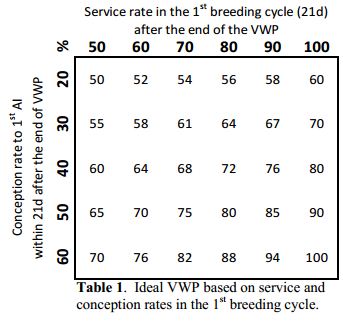



What’s the Ideal Voluntary Waiting Period for Your Dairy Herd?
Changing voluntary waiting period (VWP) across the year can capture benefits of conception and estrus through the year, advises California extension agent Dr Alex Souza.Voluntary waiting period (VWP) can be defined as the interval during the postpartum period in which producers decide not to breed cows even if estrus occurs.
It usually lasts about 50 days, but may vary a lot from herd to herd according to the breeding strategy in place. For example, VWP tends to be longer for herds relying more on synchronization programs, or may vary across cows with parity number, breed, and even calving season.
In general, dairy cows should not be inseminated before 40 to 50 days in milk because their uterine tract is not fully recovered from previous calving and conception results are normally poor. On the other hand, for healthy cows, one should not wait more than 100 days after calving to breed cows for the 1st time and risk having extended inter-calving intervals or an excessive number of non-pregnant cows that are over 150 days in milk. Thus, the ideal VWP is a fine balance between breeding as soon as possible after calving and uterine involution, and waiting long enough to ensure good conception results.
Therefore, based on the herd performance in the 1st breeding cycle after the end of the VWP, the two main variables that will dictate the most ideal VWP are:
- Estrus detection efficiency also known as service rate.
- Conception rate
With the same conception rate levels, herds that have very high service rates in the 1st breeding cycle (i.e. efficient tail chalk service, well-designed synchronization programs, etc.) may be able to have longer VWP as compared to herds with poor service rate results.
Similarly, herds having very high conception results may afford delaying time to 1st AI even until 90-100 DIM without losing on overall reproductive efficiency (i.e. days open). But be careful with conception rates to 1st AI; for every 10 days of delay in time to 1st AI, dairy producers need to capture 6-8 per cent points in conception, otherwise it is better to keep VWP shorter
Alternatively, producers might want to change the VWP across seasons to capitalize on variations of conception and estrus detection efficiency throughout the year. For instance, it is fairly common to see producers anticipating breeding or being more aggressive with timed AI programs particularly just before peak summer to take advantage of the last few weeks of good conception results before heat stress hits.
Same producers might want to keep well designed timed AI programs running all summer to compensate for lower behavioral estrus. In the heat of summer, best management approaches need to be discussed with consultants to both lower the impact of heat stress as well as to decide on best VWP and find opportunities for profitability.
Table 1 uses information on service rate and conception rate in the 1st breeding cycle after the end of the VWP to suggest the ideal VWP for your herd. Obviously, this table does not apply to all situations in all dairy herds, adds Dr Souza.
In addition, if your conception and/or service rate results for 1 st AI are low, or even fall outside of these ranges during any season of the year, you have bigger management issues to deal with than worrying too much about your VWP.



